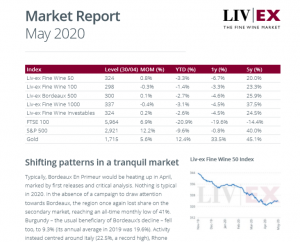 The Liv-ex May Market Report has been released.
The Liv-ex May Market Report has been released.
Containing all the latest Liv-ex research and analysis, the full issue includes:
- Shifting patterns in a tranquil market
- Major Market Movers: Gaja
- Chart of the month: Beneath the still waters
- Critical corner: Neal Martin revisits Bordeaux 2010
- Final thought: Bordeaux Wine Investment
How to access the full report
If you’re a private collector, please log in or subscribe to Cellar Watch. If you’re a fine wine merchant or a member of Liv-ex, please contact your Account Manager or email [email protected] to discuss package options.
You can download page one – with charts and data – here, or read the text below:
Shifting patterns in a tranquil market
Typically, Bordeaux En Primeur would be heating up in April, marked by first releases and critical analysis. Nothing is typical in 2020. In the absence of a campaign to draw attention towards Bordeaux, the region once again lost share on the secondary market, reaching an all-time monthly low of 41%. Burgundy – the usual beneficiary of Bordeaux’s decline – fell too, to 9.3% (its annual average in 2019 was 19.6%). Activity instead centred around Italy (22.5%, a record high), Rhone (5.2%), and the RoW (13.3%). The latter was led by USA (4.7%), Australia (3.6%) and Germany (1.3%).
The market maintained its indifference to global events: a tranquil place in the context of volatile mainstream assets. Prices drifted only slightly. The Liv-ex 50 – usually the most susceptible to sterling’s movements – gained 0.8%. The Livex 100 dipped 0.3%, the Liv-ex 1000 was down 0.4%. Within the broadest measure, the Champagne 50 rose 1.3% and the Bordeaux 500 was pancake flat. The Burgundy 150 continued its decline, dipping 0.7%, but the RoW 60 was the biggest faller, down 1.5%.
The breadth of the market continued to expand in April. Distinct wines traded were 30% more than at the beginning of 2020; the average bottle price trading on the exchange, however, has fallen 35% over that time.





